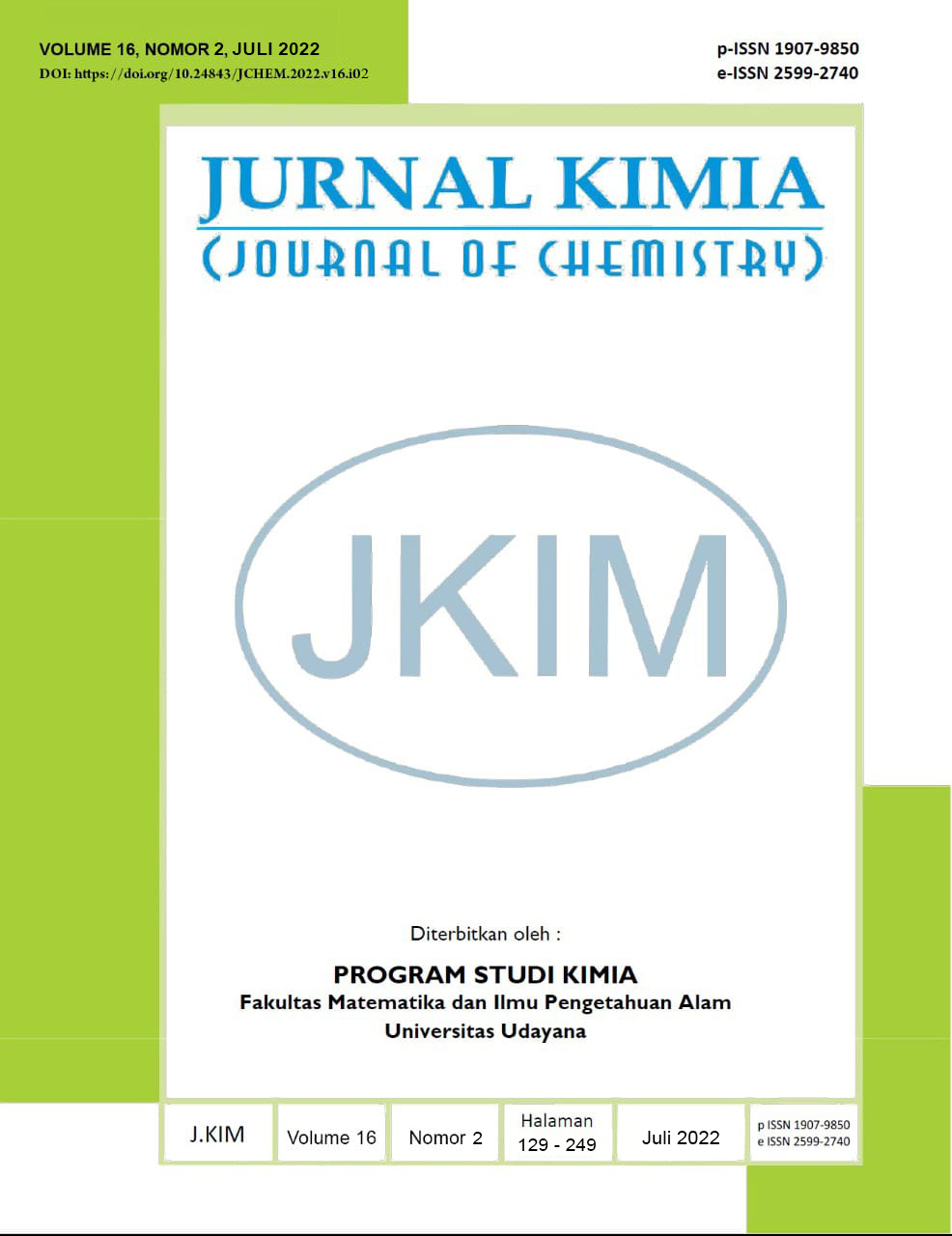PEMBENTUKAN ESTER BORAT TERKATALISIS ASAM UNTUK ANALISIS BORON SECARA SPEKTROFOTOMETRI
Abstrak
The formation of borate ester catalyzed by acid for spectrophotometric analysis of boron was investigated. It was conducted to improve the sensitivity of the boron analysis method by optimizing the type and concentration of acid catalyst that can increase the quantity of esterified boric acid. Boron was separated from the sample matrices by dissolving the boric acid in alcohols, then dehydrated into curcumin followed by spectrophotometric determination at ? 555 nm. The influence of the type and concentration of acid catalyst against the esterification rate was observed by using acetic acid, formic acid, phosphoric acid, sulfuric acid, and hydrochloric acid with a concentration of 2.5; 4.5; 6.5; 8.5, and 10.5%. Method validation was carried out under the optimal conditions and used to measure boron and its derivatives in the crackers sample. Maximum absorbance of the boron-curcumin complex was obtained by using an H2SO4 catalyst at the concentration of 2.5%. Spectrophotometric analysis of boron through borate ester distillation gave a good recovery in the range of 99.98-104.62% and acceptable repeatability of ? 2%. The limit of detection and limit of quantification was found to be 0.316 and 1.056 mg L-1, respectively. This method has a high sensitivity level with a molar absorptivity value of 4.7x105 Lmol-1cm-1. Boron content in the cracker sample ranged from 2.936 to 4.912 mgkg-1.
Keywords: acid catalyst, boron, borate ester, distillation, spectrophotometry.
##plugins.generic.usageStats.downloads##
Referensi
Almustafa, G., Sulaiman, R., Kumar, M., Adeyemi, I., Arafat, H. A. & Al Nashef, I. 2020. Boron extraction from aqueous medium using novel hydrophobic deep eutectic solvents. Chem. Eng. J. 395: 125173.
Anonim, 2015. Advanced Mass Spectrometry for Food Safety and Quality. Comprehensive Analytical Chemistry. Oxford: Elsevier.
Aranda, D. A. G., Santos, R. T. P., Tapanes, N. C. O., Ramos, A. L. D. & Antunes, O. A. C. 2008. Acid-Catalyzed Homogeneous Esterification Reaction for Biodiesel Production from Palm Fatty Acids. Catal. Lett. 122(1–2): 20–25.
Bao, Z., Zhang, W., Cui, X. & Xu, J. 2015. Theoretical Prediction and Experimental Determination of Vapour-Liquid Equilibrium for Ternary Systems Trimethyl Borate-Methanol-N, N-Dimethylformamide/N, N-Dimethylacetamide. Asian J. Chem. 27(8): 2883–2886.
Cezário, P. S. de O., do Nascimento, M. C. L., Luna, A. S. & de Gois, J. S. 2020. Application of a lab-made ternary Fe-Cr-Al coil vaporizer coupled to ICP OES for boron determination in powdered food after the sample preparation in alkaline media. Microchem. J. 157: 104875.
Franca, A. S. & Nollet, L. M. L. ed., 2018. Spectroscopic methods in food analysis. Boca Raton: CRC Press, Taylor & Francis Group.
Hadrup, N., Frederiksen, M. & Sharma, A. K. 2021. Toxicity of boric acid, borax and other boron containing compounds: A review. Regul. Toxicol. and Pharmacol. 121: 104873.
Harmita, H. 2004. Petunjuk Pelaksanaan Validasi Metode Dan Cara Perhitungannya. Majalah Ilmu Kefarmasian. 1(3): 117–135.
Khadka, D., Amgain, R., Joshi, S., Shrestha, G., Baral, B.R., Chaurisiya, V., Thapa, K.B., Shrestha, S. & Shrestha, S. R. 2018. Evaluation of different methods of boron extraction under plain deep soil domains of Nepal. J. Nep. Agric. Res.17: 192-199.
Ozbek, N. & Akman, S. 2015. Determination of boron in Turkish wines by microwave plasma atomic emission spectrometry. LWT - Food Sci. Technol. 61(2): 532–535.
Park, C. J. & Song, S. 2003. Determination of boron in high-purity sulfuric acid by ester generation and isotope dilution inductively coupled plasma mass spectrometry. J. of Anal. At. Spectrom. 18: 1248-1251.
Rani, M. & Meena, M. C. 2013. Multiple Organ Damage Due to Boric Acid Toxicity. Asia Pac. J. Med.Toxicol. (APJMT). 2(4): 157-159.
Ratri, M.C. 2017. Validasi Metode Analisis Surfaktan Anionik Natrium Dodesil Benzena Sulfonat (Sdbs) Dalam Ikan Lele Secara Spektrofotometri UV-Vis Menggunakan Acridine Orange. ALCHEMY Jurnal Penelitian Kimia. 13(2): 147-165.
Sarica, D. Y. & Ertas, N. 2001. Flow Injection Analysis for Boron Determination by Using Methyl Borate Generation and Flame Atomic Emission Spectrometry. Turk. J. Chemistry. 25(3): 305-310.
Thangavel, S., Dhavile, S. M., Dash, K. & Chaurasia, S. C. 2004. Spectrophotometric determination of boron in complex matrices by isothermal distillation of borate ester into curcumin. Anal. Chim. Acta. 502(2): 265–270.
Wang, X. 2017. Boron quantitative analysis and imaging analysis in plants. Disertation. University of Missouri. Columbia.
Wilschefski, S. & Baxter, M. 2019. Inductively Coupled Plasma Mass Spectrometry: Introduction to Analytical Aspects. Clin. Biochem. Rev. 40(3): 115–133.
Zaijun, L., Zhengwei, C. & Jian, T. 2006. The determination of boron in food and seed by spectrophotometry using a new reagent 3,4-dihydroxyazomethine-H. Food Chem. 94(2): 310–314.
Zhang, R., Xie, Y., Song, J., Xing, L., Kong, D., Li, X.-M. & He, T. 2016. Extraction of boron from salt lake brine using 2-ethylhexanol. Hydrometallurgy. 160: 129–136.

This work is licensed under a Creative Commons Attribution 4.0 International License






